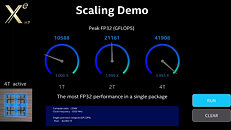- Joined
- Aug 19, 2017
- Messages
- 2,929 (1.05/day)
Raja Koduri, Intel's chief architect and senior vice president of Intel's discrete graphics division, has today held a talk at HotChips 32, the latest online conference of 2020, that shows off the latest architectural advancements in the semiconductor industry. So Intel has prepared two talks, one about Ice Lake-SP server CPUs and one about Intel's efforts in the upcoming graphics card launch. So what has Intel been working on the whole time? Raja Koduri took over the talk and has benchmarked the upcoming GPU and recorded how much raw power the GPUs posses, possibly counting in PetaFLOPs.
When Mr. Koduri got to talk, he pulled the 4-tile Xe HP GPU out of his pocket and showed for the first time how the chip looks. And it is one big chip. Featuring 4 tiles, the GPU represents Intel's fastest and biggest variant of Xe HP GPUs. The benchmark Intel ran was made to show off scaling on the Xe architecture and how the increase in the number of tiles results in a scalable increase in performance. Running on a single tile, the GPU managed to develop the performance of 10588 GFLOPs or around 10.588 TeraFLOPs. When there are two tiles, the performance scales almost perfectly at 21161 GFLOPS (21.161 TeraFLOPs) for 1.999X improvement. At four tiles the GPU achieves 3.993 times scaling and scores 41908 GFLOPs resulting in 41.908 TeraFLOPS, all measured in single-precision FP32.



Mr. Koduri has mentioned that the 4-tile chip is capable of "PetaFLOPs performance" which means that the GPU is going to be incredibly fast for tasks like machine learning and AI. Given that the GPU supports tensor cores if we calculate that it has 2048 compute units (EUs), capable of performing 128 operations per cycle (128 TOPs) and the fact that there are about 2 FMA (Fused Multiply-Add) units, that equals to about 524,288 FLOPs of AI power. This means that the GPU needs to be clocked at least at 2 GHz clock to achieve the PetaFLOP performance target, or have more than 128 TOPs of computing ability.
View at TechPowerUp Main Site
When Mr. Koduri got to talk, he pulled the 4-tile Xe HP GPU out of his pocket and showed for the first time how the chip looks. And it is one big chip. Featuring 4 tiles, the GPU represents Intel's fastest and biggest variant of Xe HP GPUs. The benchmark Intel ran was made to show off scaling on the Xe architecture and how the increase in the number of tiles results in a scalable increase in performance. Running on a single tile, the GPU managed to develop the performance of 10588 GFLOPs or around 10.588 TeraFLOPs. When there are two tiles, the performance scales almost perfectly at 21161 GFLOPS (21.161 TeraFLOPs) for 1.999X improvement. At four tiles the GPU achieves 3.993 times scaling and scores 41908 GFLOPs resulting in 41.908 TeraFLOPS, all measured in single-precision FP32.



Mr. Koduri has mentioned that the 4-tile chip is capable of "PetaFLOPs performance" which means that the GPU is going to be incredibly fast for tasks like machine learning and AI. Given that the GPU supports tensor cores if we calculate that it has 2048 compute units (EUs), capable of performing 128 operations per cycle (128 TOPs) and the fact that there are about 2 FMA (Fused Multiply-Add) units, that equals to about 524,288 FLOPs of AI power. This means that the GPU needs to be clocked at least at 2 GHz clock to achieve the PetaFLOP performance target, or have more than 128 TOPs of computing ability.
View at TechPowerUp Main Site





